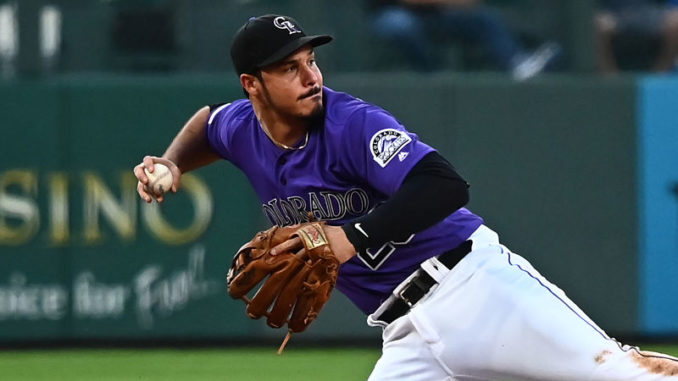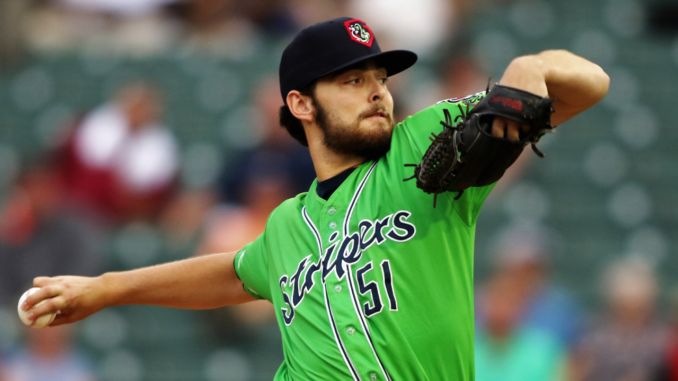
In the wake of Josh Donaldson‘s decision to sign with the Minnesota Twins rather than return to the Atlanta Braves, fans and sportswriters have been casting about for alternatives to the unthinkable… having essentially the same line-up that won the NL East in 2018.
Wait, maybe that’s not so bad, but it’s understandable that a season after the Braves had the 7th-most potent offense in the major leagues with the addition of Donaldson batting out of the clean-up spot, going back to Johan Camargo (or relying on the still-unproven Austin Riley) feels like a step back for a team that otherwise is primed for a World Series run.
And while the free agent market still has a couple of good hitters available in the form of outfielder Marcell Ozuna and Nick Castellanos, the trade market offers a more intriguing option: Colorado Rockies third baseman Nolan Arenado.

Arenado: By The Numbers
Age: 28
Bats: R
Acquired: Drafted, 2nd-round 2009
Career batting: .295/.351/.546 | 1031 G, 4357 PA | 227 HR, 16 SB | 8.0 BB%, 15.2% K% | 120 wRC+ | 31.3 fWAR
2019 batting: .315/.379/.583 | 155 G, 662 PA | 41 HR, 3 SB | 9.4 BB%, 14.0 K% | 128 wRC+ | 5.9 fWAR
Over the last three seasons, Arenado has been a top-10 position player by all three publicly available versions of WAR. Because he has been a Colorado Rockie (Rocky? Rockee?), fans will automatically look at gaudy offensive numbers skeptically, but WAR and wRC+ are weighted by ballpark as well, so they are designed to neutralize the Mile High advantage.
Defensively, Arenado has won the National League Gold Glove at third base for all 7 seasons he has been in the major leagues. For those wanting a more objective view of his defensive bona fides, Arenado was credited with 17 Outs-Above-Average in 2019 in the new Statcast metric that attempts to quantify infield defense, leading all major league third basemen.
In short, Arenado is an elite veteran ball player, still in the prime of his career. But here’s some more numbers:
2020 (age 29): $35,000,000
2021 (age 30): $35,000,000
2022 (age 31): $35,000,000
2023 (age 32): $35,000,000
2024 (age 33): $35,000,000
2025 (age 34): $32,000,000
2026 (age 35): $27,000,000
Arenado is an elite veteran ball player that is getting paid like an elite veteran ballplayer. The average annual value of his contract is in the top 10 of the major leagues, and only slightly under the current top AAV king, newly minted Yankee Gerrit Cole. Arenado’s 2019 production still provided excess value to the Rockies beyond the $35 million paid to him last year and there’s no concrete reason to think that Arenado would significantly slide to the point where this contract would be “under water” through at least 2022. After that it gets a little trickier, as aging curves show that most position players start significantly declining around age 32.

Overall, the contract points to being approximately worth Arenado’s value, but without significant surplus value.
Complicating any potential valuation are two other items: Arenado has a full no-trade clause and also can opt-out of the contract and elect free agency after the 2021 season. While neither clause would seem to be an issue as to actually getting a trade completed, they do overall bring down the value of the deal by increasing the level of uncertainty.
Boring Budget Stuff
The Atlanta Braves don’t reveal what their budget is from year-to-year, but typically it can be surmised by spending. That hasn’t been the case this offseason, as the Braves have already surpassed their largest ever Opening Day payroll, and even there were reportedly in the hunt for Donaldson until the end. If it is assumed that the Braves were willing to approach last year’s salary for Donaldson, $23 million, in the effort to retain him, and the Braves wanting to reserve around $8 million for in-season moves as needed, then the Braves payroll budget is likely now at least now close to $170 million.
The Braves could absorb Arenado’s $35 million salary into that budget, but it would eat up all of the reserve, leaving the team in a position where they may not be able to make in-season moves to account for unexpected injury or lack of performance for key players.
Finally, while GM Alex Anthopoulos has very publicly said that CEO Terry McQuirk has never told him “no” in relation to acquiring a player, McQuirk himself has indicated that the team does not want to be in the position again of carrying significant “dead money” — payroll devoted to playing players that have been cut or traded from the organization.

Building A Trade
What do the Rockies want for Arenado? That’s a significant question. In reporting from different sources this offseason, the Rockies are looking for a significant return of major league or near-major league players. Centerfield seems to be an area of concern, understandable given the dimensions of their stadium.
A recent Call to the Pen analysis of Arenado’s surplus value pegged an even exchange of OFR #3 prospect RHP Ian Anderson for Arenado as both fair from a value standpoint, and one that would likely cause a riot by Rockies fans. I can’t disagree with this assessment.
On the other side, Braves beat writer Mark Bowman posted a hypothetical trade for Arenado that included not just Anderson, but also OFR #2 prospect OF Drew Waters, #10 prospect RHP Jasseel De La Cruz, and outfielder Ender Inciarte. On one hand, the Rockies would happily jump at this offer, and there is a large segment of Braves fans that would happily sign off on it as well. It does however represent a gross overpayment.
To bridge the gap between these extremes, and to give the Braves the cushion they need for in-season moves, the Rockies would likely need to pay down at least part of Arenado’s salary. Including Inciarte in the deal and giving the Rockies the plus-defensive outfielder they covet would also clear $7 million from the current season payroll. The Rockies could then contribute $5 million for each of the 2020 and 2021 seasons and the Braves would be outlaying a net of $23 million for Arenado, equal to their outlay on Donaldson in 2019.
At that point, I would give the Rockies a choice of any one of Anderson or right-hander Kyle Wright. Both are currently considered Top 50 prospects in baseball according to Baseball America. I would not include outfielders Cristian Pache or Drew Waters; the endgame of the Braves core this decade would include both of them starting in the outfield alongside Ronald Acuña Jr., a necessary development from both on-field and budgetary reasons; without a continued flow of high-quality young players, the Braves could find themselves unable to do things like extend first baseman Freddie Freeman or add to the pitching staff. I would also try to avoid including third baseman Austin Riley, given his potential upside. He could be an important reserve in case of injury at any corner position, could start in the outfield in case either Waters or Pache doesn’t live up to expectations, or he could be used for his future trade value.
If the Rockies insisted on a third piece, there is a slew of potential upside talent in the 11-24 range of the OFR Top Prospects List (note: I do not view Jasseel De La Cruz as a “lottery ticket” as Bowman describes him). Given the Rockies constant need for pitching, I suspect a strikeout machine like RHP Huascar Ynoa would interest them. Beyond this we get into the realm of significant overpay; here is where both teams do need to consider the negative value of the no-trade and opt-out clauses that could cause Atlanta to suddenly be out a star player in two seasons or not be able to trade the player if circumstances change with the team and they look to move on.
So in short, I believe a reasonable deal would be:
Braves receieve 3B Nolan Arenado, cash considerations ($10 million)
Rockies receive RHP Ian Anderson (or RHP Kyle Wright), OF Ender Inciarte, RHP Huascar Ynoa (or similar-valued prospect)

No Cap, that trade makes me queasy. I really like Ian Anderson.

A well thought out opinion which I find little, if anything, to disagree with.
We Braves fans want the best for our Team and nothing less than winning the World Series will do. However, let us keep in mind that the Braves franchise is in the entertainment business which is made to appear as a sport. AA knows what is needed to bring success. He also knows that $$$ alone is not the answer. He is building for the now and for the years beyond. Personally, I trust that AA is making the best decisions he can make to fulfill his Vision of Making the Braves Great, Again and Again!
So, my advice to each of us is, 1) quite trying to spend Liberty’s money no matter the cost, and 2) trust AA and get ready for Spring Training 2020. The Hot Stove League is just that, a collection of opinions, wants & wishes.
Batter Up!